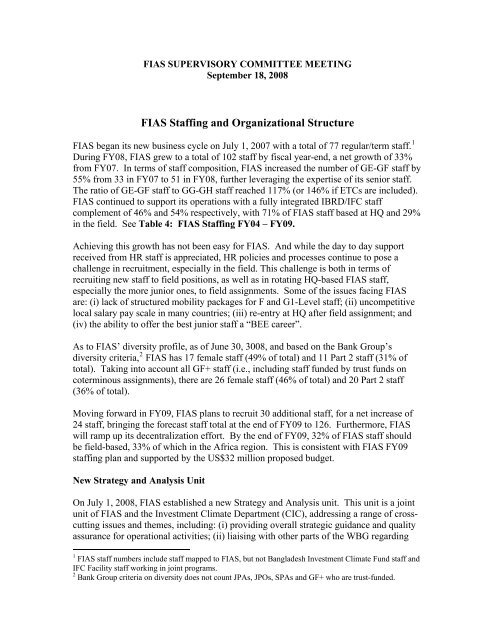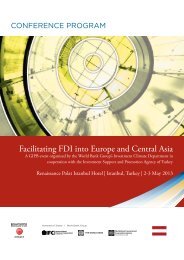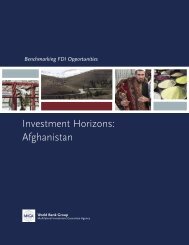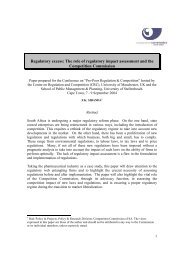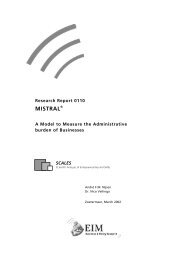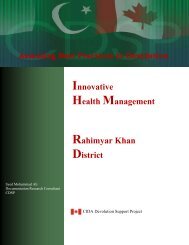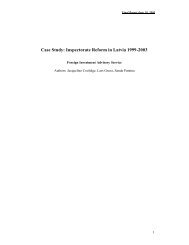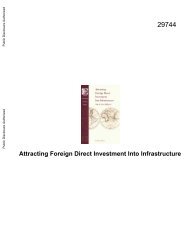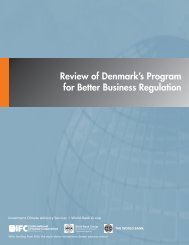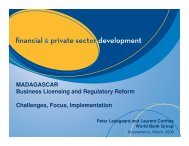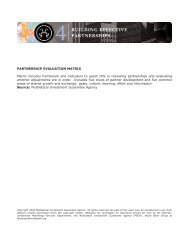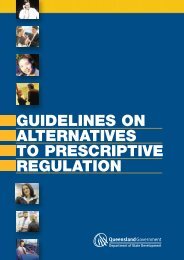Staffing and Organizational Structure - Investment Climate
Staffing and Organizational Structure - Investment Climate
Staffing and Organizational Structure - Investment Climate
You also want an ePaper? Increase the reach of your titles
YUMPU automatically turns print PDFs into web optimized ePapers that Google loves.
FIAS SUPERVISORY COMMITTEE MEETINGSeptember 18, 2008FIAS <strong>Staffing</strong> <strong>and</strong> <strong>Organizational</strong> <strong>Structure</strong>FIAS began its new business cycle on July 1, 2007 with a total of 77 regular/term staff. 1During FY08, FIAS grew to a total of 102 staff by fiscal year-end, a net growth of 33%from FY07. In terms of staff composition, FIAS increased the number of GE-GF staff by55% from 33 in FY07 to 51 in FY08, further leveraging the expertise of its senior staff.The ratio of GE-GF staff to GG-GH staff reached 117% (or 146% if ETCs are included).FIAS continued to support its operations with a fully integrated IBRD/IFC staffcomplement of 46% <strong>and</strong> 54% respectively, with 71% of FIAS staff based at HQ <strong>and</strong> 29%in the field. See Table 4: FIAS <strong>Staffing</strong> FY04 – FY09.Achieving this growth has not been easy for FIAS. And while the day to day supportreceived from HR staff is appreciated, HR policies <strong>and</strong> processes continue to pose achallenge in recruitment, especially in the field. This challenge is both in terms ofrecruiting new staff to field positions, as well as in rotating HQ-based FIAS staff,especially the more junior ones, to field assignments. Some of the issues facing FIASare: (i) lack of structured mobility packages for F <strong>and</strong> G1-Level staff; (ii) uncompetitivelocal salary pay scale in many countries; (iii) re-entry at HQ after field assignment; <strong>and</strong>(iv) the ability to offer the best junior staff a “BEE career”.As to FIAS’ diversity profile, as of June 30, 3008, <strong>and</strong> based on the Bank Group’sdiversity criteria, 2 FIAS has 17 female staff (49% of total) <strong>and</strong> 11 Part 2 staff (31% oftotal). Taking into account all GF+ staff (i.e., including staff funded by trust funds oncoterminous assignments), there are 26 female staff (46% of total) <strong>and</strong> 20 Part 2 staff(36% of total).Moving forward in FY09, FIAS plans to recruit 30 additional staff, for a net increase of24 staff, bringing the forecast staff total at the end of FY09 to 126. Furthermore, FIASwill ramp up its decentralization effort. By the end of FY09, 32% of FIAS staff shouldbe field-based, 33% of which in the Africa region. This is consistent with FIAS FY09staffing plan <strong>and</strong> supported by the US$32 million proposed budget.New Strategy <strong>and</strong> Analysis UnitOn July 1, 2008, FIAS established a new Strategy <strong>and</strong> Analysis unit. This unit is a jointunit of FIAS <strong>and</strong> the <strong>Investment</strong> <strong>Climate</strong> Department (CIC), addressing a range of crosscuttingissues <strong>and</strong> themes, including: (i) providing overall strategic guidance <strong>and</strong> qualityassurance for operational activities; (ii) liaising with other parts of the WBG regarding1 FIAS staff numbers include staff mapped to FIAS, but not Bangladesh <strong>Investment</strong> <strong>Climate</strong> Fund staff <strong>and</strong>IFC Facility staff working in joint programs.2 Bank Group criteria on diversity does not count JPAs, JPOs, SPAs <strong>and</strong> GF+ who are trust-funded.
private sector development activities; (iii) developing <strong>and</strong> implementing the BusinessEnabling Environment (BEE) monitoring <strong>and</strong> evaluation system (in close cooperationwith IFC’s M&E unit for Advisory Services); (iv) managing the development <strong>and</strong>dissemination of BEE knowledge products; (v) coordinating learning activities for staff<strong>and</strong> partner organizations; (vi) overseeing internal <strong>and</strong> external communications; (vii)providing support to product <strong>and</strong> project teams on specialized issues such as ITapplication for BEE; <strong>and</strong> (viii) conducting economic analysis relating to the workprogram. The mainstreaming of the competition dimension into all aspects of FIAS workis another key role of this unit.Following a competitive selection process, Ms. Cecile Fruman was appointed Manager ofthis new unit effective July 1, 2008. To date, there is a total of 15 CIC/FIAS staffreporting to this new unit, of which 8 are FIAS staff.A write up on FIAS’ organizational structure <strong>and</strong> FIAS’ organizational chart as ofSeptember 2008 are attached below.2
FIAS – <strong>Organizational</strong> Overview(September 2008)FIAS is the World Bank Group’s multi-donor <strong>Investment</strong> <strong>Climate</strong> Advisory Service. It advises governments ofdeveloping <strong>and</strong> transition countries on how to improve their investment climates for domestic <strong>and</strong> foreigninvestors. IFC, MIGA, <strong>and</strong> the World Bank contribute to its funding, <strong>and</strong> a wide range of donors provide cofinancingfor FIAS in general as well as for programs <strong>and</strong> projects undertaken by FIAS. The FIAS program isadministered by IFC. It includes IFC, MIGA <strong>and</strong> Bank staff <strong>and</strong> is structured as follows:HQ TeamFIAS’ HQ operations, based in Washington DC, are organized around three units focused on FIAS’ eight coreproducts, <strong>and</strong> one unit focused on cross-cutting functions, as follows:• Regulatory Simplification (CICRS) (Senior Manager: Tom Davenport)The Regulatory Simplification unit builds on FIAS’ established leadership role in designing, catalyzing <strong>and</strong>supporting regulatory reform. It focuses in particular on the following Business Enabling Environment (BEE)products essential to business-friendly investment <strong>and</strong> trade environments: (i) Business Entry: reducing theburden of business registration <strong>and</strong> facilitating formalization of enterprises, including support to businessregistries; (ii) Regulatory Governance <strong>and</strong> Business Licensing: streamlining licenses, permits <strong>and</strong> inspectionsrequired in the course of operating a business, including Regulatory Impact Analysis (RIA) <strong>and</strong> regulatorycapacity building in the public <strong>and</strong> private sectors; (iii) Business Taxation: tax policies, rules <strong>and</strong> procedures, inparticular those affecting SMEs <strong>and</strong> the informal sector; <strong>and</strong> (iv) Trade Logistics: abolishing or simplifyingprocedures that stifle cross-border trade. FIAS is also the lead unit for an Access to Finance (A2F) product,namely (v) Secured Lending with focus on the improvement of collateral systems <strong>and</strong> registries.• <strong>Investment</strong> Generation (CICIG) (Manager: Ceci Sager)The <strong>Investment</strong> Generation unit helps client countries attract foreign investment while they work through thelonger-term reform agenda: (i) <strong>Investment</strong> Policy <strong>and</strong> Promotion, promoting an effective legal, policy <strong>and</strong>institutional framework for investment, coupled with complementary assistance to help market the improved, orimproving, business environment to foreign investors; <strong>and</strong> (ii) Industry Competitiveness, capitalizing on FIAS’expertise <strong>and</strong> experience in industry- <strong>and</strong> competition-specific policy analysis <strong>and</strong> reform strategies. FIAS’industry-specific work currently focuses on agribusiness, tourism, special economic zones (with particularemphasis on conflict-affected environments), <strong>and</strong> l<strong>and</strong> policy. The bulk of the TA team that transferred fromMIGA in 2007 is in this unit. In addition, the unit is leading the implementation of the policy components ofIFC’s Health in Africa initiative in close collaboration with the World Bank’s Africa Human DevelopmentDepartment.• Doing Business Reform (CICRA) (Manager: Marialisa Motta)The main objective of the Doing Business (DB) Reform unit, a joint FIAS-DB unit established in October 2007,is to ensure, in close cooperation with other units of the World Bank Group, the rapid <strong>and</strong> effective follow-up toclient requests for support in designing <strong>and</strong> implementing reforms along the Doing Business agenda. The DBReform unit can address, via targeted, brief interventions, all ten areas included in the annual DB Reports:starting a business, dealing with construction permits, employing workers, registering property, getting credit,protecting investors, paying taxes, trading across borders, enforcing contracts <strong>and</strong> closing a business. The unitalso serves as a central resource, in terms of both people <strong>and</strong> codified knowledge, available to internal <strong>and</strong>3
external clients. The two core products managed by the DB Reform unit are: (i) DB Reform Advisory for shortterminterventions at the national level, <strong>and</strong> (ii) Sub-national DB Support for DB-based benchmarking <strong>and</strong>reform support interventions undertaken for <strong>and</strong> with clients at the provincial or municipal level.• Strategy <strong>and</strong> Analysis (CICSA) (Manager: Cecile Fruman)The Strategy <strong>and</strong> Analysis unit is a joint unit of FIAS <strong>and</strong> the <strong>Investment</strong> <strong>Climate</strong> department (CIC), addressinga range of cross-cutting issues <strong>and</strong> themes, including: (i) providing overall strategic guidance <strong>and</strong> qualityassurance for operational activities; (ii) liaising with other parts of the WBG regarding private sectordevelopment activities; (iii) developing <strong>and</strong> implementing the Business Enabling Environment (BEE)monitoring <strong>and</strong> evaluation system (in close cooperation with IFC’s M&E unit for Advisory Services); (iv)managing the development <strong>and</strong> dissemination of BEE knowledge products; (v) coordinating learning activitiesfor staff <strong>and</strong> partner organizations; (vi) overseeing internal <strong>and</strong> external communications; (vii) providing supportto product <strong>and</strong> project teams on specialized issues such as IT application for BEE; <strong>and</strong> (viii) conductingeconomic analysis relating to the work program. The mainstreaming of the competition policy dimension into allaspects of FIAS work is another key role of this unit.Field-based Teams• East Asia <strong>and</strong> Pacific (Manager: Russell Muir)• Africa (Manager: David Bridgman)Beyond the above-mentioned HQ-based units, FIAS has a number of field-based offices which are closelyintegrated with IFC’s regional advisory services. Many of these offices are staffed with joint FIAS/BEEmanagers who simultaneously report to FIAS <strong>and</strong> the respective regional Head of IFC Advisory Services. Twoof these regional teams are led by FIAS Managers, namely Africa (David Bridgman, Acting) <strong>and</strong> East Asia &Pacific (Russell Muir). The other regional teams are led by Program Managers reporting to the Head of theconcerned regional IFC advisory services team on one h<strong>and</strong> <strong>and</strong> to a FIAS Manager on the other. Finally, itshould be mentioned that FIAS <strong>and</strong> CIC include IFC, MIGA as well as Bank staff.FIAS General Manager (Pierre Guislain)The FIAS General Manager is in charge of the overall FIAS program under the oversight of the FIASSupervisory Committee, which is chaired by the Executive VP <strong>and</strong> CE0 of IFC (Lars Thunell) <strong>and</strong> also includesthe Executive VP of MIGA (James Bond, Acting), the Bank’s VP in charge of PSD (Michael Klein) <strong>and</strong> IFC’sVP for Advisory Services (Rachel Kyte). Pierre Guislain is also the Director of the World Bank Group’s<strong>Investment</strong> <strong>Climate</strong> Department <strong>and</strong> leader of IFC’s Business Enabling Environment business line.<strong>Organizational</strong> ChartFIAS’ organizational chart is attached; it includes non-FIAS roles taken on by FIAS staff.4


